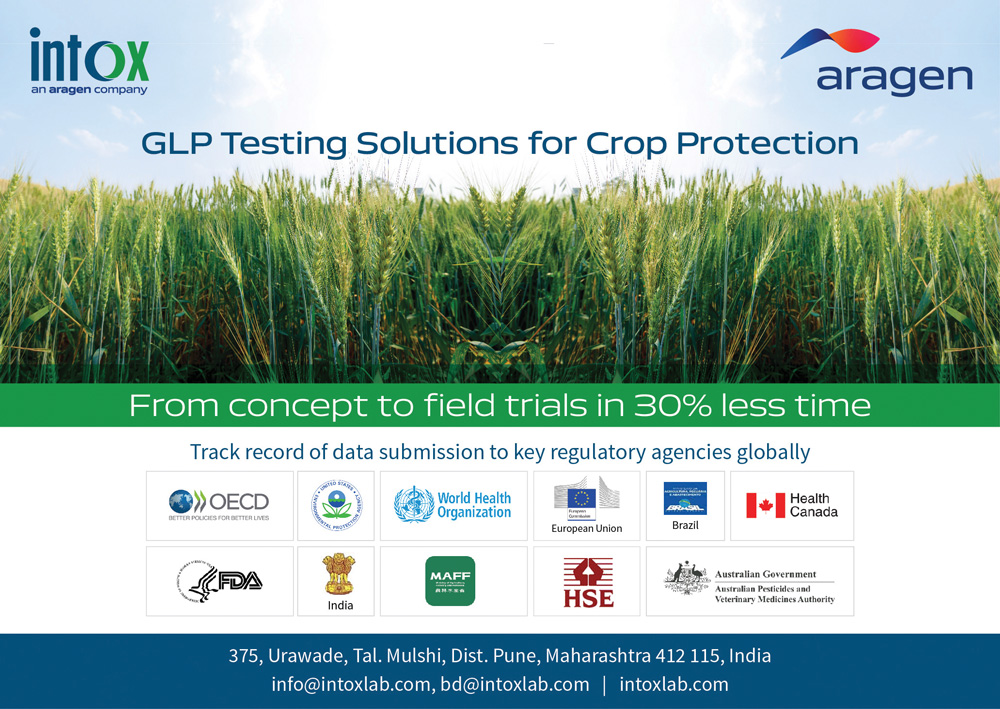Entering the Biologicals Market in India
Scroll Down to Read
By Renee Targos
While India is not Brazil as far as biological adoption, the country shows promising growth. With biocontrol and biostimulants growing at an average of 15% per annum over the past five years as reported by AgbioInvestor, the potential for expansion is there.
Mark Trimmer, President and Founding Partner for DunhamTrimmer believes the country could be the next Brazil if certain requirements were met.

Mark Trimmer, President and Founding Partner for DunhamTrimmer
“The one country we always focus on and point to is Brazil, because it is where all the growth is happening,” says Trimmer. “I think India has the same potential opportunity if the government policy programs support the development of the market and help with the education of growers and users. I think there can be a huge market potential in the Indian subcontinent.”
Currently, AgbioInvestor reports India ranks as the seventh largest market for both biocontrol ($70 million in 2022) and biostimulants ($130 million in 2022). DunhamTrimmer reports there are different adoption rates within the various biological categories.
“Botanical products dominate the biopesticide sector with neem-based products being predominant. Several companies are developing some innovative microbial solutions, so that is a growth area for the future. More technical training on how to use microbial products successfully is needed,” says Trimmer. “Biostimulant products are well established, and grower awareness of these products and how to use them is higher. Many of these products offer good margin opportunities for the distribution channel as well.”
Kamlesh Punjabi, Senior Director, Southeast Asia region and India for Kynetec agrees with Trimmer.

Kamlesh Punjabi, Senior Director, Southeast Asia region and India for Kynetec
“If you look by type analysis, the market is segregated into biofertilizers, biopesticides/biocontrol, and biostimulants. It is the biostimulants segment that accounts for a higher usage owing to increased product adoption for improving soil health,” says Punjabi. “If you want to understand by the mode of application method, it is clearly the foliar spray (versus soil treatment, seed treatment, others) that will hold major share as it promotes easier application of biologicals on the crops.”
While introducing a new product into India’s biologicals market has various challenges to overcome, businesses can find opportunities if workarounds are achieved. Here are five challenges that could present an opening to a niche market for your business.
1. Fragmented Farming
One of the biggest challenges for launching a product in India is that “80% of the country’s 93 million farm households consist of smallholders with less than two hectares of land,” says Lawrence Middler, Senior Analyst for AgbioInvestor.
This means companies will need to invest boots on the ground to build relationships with ag retailers and growers, finding out their pain points and building trust. However, this is not an easy accomplishment with the size of the country.
“The entire Indian subcontinent is a huge land mass,” says Trimmer. “If you think about that entire country, there’s probably at least 1,000 retailers that you have to deal with now in crop protection. Fortunately, very few biologicals are going to need to reach every single retailer. If your company is only going after a certain specialty crop in a unique area, that number probably drops to less than 100 retailers. It still will be significantly more than a manufacturer will be accustomed to dealing with certainly in the U.S., Brazil or EU.”
It also means that distribution logistics can be difficult especially if a company’s product has a short shelf life or needs cold chain storage. There are also security concerns as well as transportation issues in the mountainous regions.
“If you’ve got a biological that requires special handling like refrigeration, that will be extremely challenging in the Indian market,” says Trimmer. “It’s challenging in any market, but when you combine refrigeration with a very fragmented distribution channel that requires hundreds of retailers to have a cold chain set up to handle your product, it just doesn’t exist. You’ve got to have a product that you know can fit into a grower’s normal practices.”
Opportunity: Create products with extended shelf life.
“Companies must make substantial investments to enhance the range, stability, controlled usage, and shelf-life of their biological products,” says Punjabi. “The R&D process is usually longer for the biologicals. However, the resulting products can have a profound impact to enhance farm productivity and achieve environmental sustainability. It will also have a positive impact on the grower’s return of investment (ROI) to further encourage the shift toward these natural solutions, marking a significant trend of a higher adoption rate.”
2. Grower Adoption
As in many regions around the world, Indian growers are used to the quick acting synthetic crop protection products. There is work that needs to be done to convince growers of the efficacy, different preventative application process, and financial investment of biologicals.
“Though effective, some biological solutions don’t provide the fast response that growers are used to and it will take a change in mindset for growers to measure their expectations of the response rate,” says Punjabi. “This aspect originates from a basic point of the lack of biologicals awareness among the Indian growers whose expectations are more guided by what they get from the chemicals.”
The Government of India established 729 Krishi Vigyan Kendras (KVKs) or farm science centers at district levels to educate growers about seed varieties, crop protection products, and ag tech.
“India has been progressive,” says Trimmer. “They started a national sustainable agriculture support program which focused on biologicals. The farm science centers are definitely involved in testing and demonstrating the value of these products. This is critical, because growers are accustomed to seeing knock down activity with chemicals. Using biologicals is preventative and requires a different mindset and approach for pest control. That’s why education really becomes critical.”
Other Government of India initiatives to encourage growers to use biologicals are through schemes via Paramparagat Krishi Vikas Yojana (PKVY) and Mission Organic Value Chain Development for Northeastern Region (MOVCDNER).
“Biofertilizers and biopesticides are also promoted through integrated nutrient management (INM) and integrated pest management (IPM) and made integral part of package of practices developed by Indian Council of Agricultural Research (ICAR) and state agriculture universities,” says Punjabi. “KVKs also conduct training to farmers on INM and IPM practices to promote use of biofertilizers and biopesticides. All these schemes will benefit companies with higher awareness among growers and understanding of various attributes of the biological products.”
Additional agronomy services are being provided by non-government organizations and agrochemical companies as far as online tutorials and other supports.

Lawrence Middler, Senior Analyst for AgbioInvestor.
“There are telephone advice services where growers can consult advisors on issues in their production,” says Middler.
“This is in part facilitated by moderate to high smart phone penetration even in a developing nation such as India. This can also allow basic digital ag applications to be employed to assist with pest identification and product recommendations. All of these factors can help with the decision-making process to use biopesticide and biostimulant products.”
Opportunity: Enter the market as a trusted partner. Create or partner with educational programs for ag retailers and growers.
“Work with local partners to communicate the benefits of products, while also gaining feedback of field challenges and performance,” says Middler.
Trimmer agrees with working to understand the needs of your customer.
“The number one key to market access is understanding the end user. For the small landholders of India, it could be simple things like packaging size or how you deliver the product,” says Trimmer. “Is your product easy for them to use with the kind of equipment that they have available to them? Is your product formulated appropriately for their needs? All those kinds of details can remove barriers that will allow you to better access this market.”
3. Lower Amount of Crop Inputs
In a press release from the Pesticides Manufacturers & Formulators Association of India (PMFAI), it stated that India is one of the lowest pesticide consuming countries in the world with 0.65 gm/hectare against the global average of 3 kg/hectare.
“Cultivation is undertaken at a significantly lower level of intensification compared to more developed markets,” says Middler, “with India typically using just a quarter of the crop protection inputs per hectare of the global average, around 10% of Brazil and around 5% of those used in China.”
Opportunity: While there is a dependence on the products being used, there is a window for entry.
“Further technify production and move closer to the theoretical yield potential for a given crop,” says Middler.
4. Lower Incomes
AgbioInvestor reports that Indian farm incomes “typically fall below even that of the average per-capita income for the nation as a whole.”
“Liquidity through access to credit is also a concern due to the often-higher price point,” says Middler. “The government has put in place steps to waive farm debt but given that less than one sixth of farmers qualify for credit in the first place, this is likely to have only a limited impact and could downgrade those growers future lendability.”
The Government of India has mandated minimum support price (MSP) mechanisms to promote production and stabilize domestic stocks in rice, wheat, cotton, oilseeds, and other crops.
“Despite increases to MSP rates in the 2023/2024 season, many farmers remain dissatisfied with the implementation of the system and are seeking a more formalized legal provision of the scheme with greater coverage of other crops, as wheat and rice become affected by more frequent droughts,” says Middler.
As growers move to diversify their crops, this trend is also being fed by India’s growing middle class population seeking organic standards or food produced sustainably.
“In 2022, around 30% of the value of the crop protection industry in India came from fruits and vegetables (F&V) crops,” says Middler. “Following the COVID-19 lockdowns, the organic food sector expanded, due in part to the growth of e-commerce. For example, user numbers have been increasing at the government supported ‘Jaivikkheti’ online portal, which facilitates small farmers selling organic products directly to consumers. It also goes without saying that population increases within India will drive the need for further technification of production, with population in India projected to reach around 1.7 billion by 2075.”
Opportunity: Make your product price reflect the local economy. Find niche markets in fruits and vegetables.
5.Climate Change
As climate change impacts growers with increased torrential rains, heat waves and droughts, India growers are turning to biostimulants to help plants weather abiotic stressors. As the government implemented stricter regulations for biostimulants, higher quality products have entered the market with greater efficacy and garnered trust from growers.
“The estimated Indian biostimulants market grew to $308 million in 2023,” says Punjabi. “The projected value is close to $850 million from 2023 to 2030 recording 15.6% CAGR.”
Growers are leaning on biostimulants, including humic acids, amino acids, and seaweeds.
Climate change is also bringing different pest populations. Growers also needing solutions to not only abiotic stressors but also new migrations of insects.
“India features a broad range of climatic zones from wet tropical and sub-tropical through to semi-arid, arid, temperate and alpine,” says Middler. “Products need to demonstrate robust efficacy, stability and persistence across a range of field conditions, or at least be tailored to individual regions and pest populations, all of which can add complexity and cost to the marketing company.”
Opportunity: Find niche F&V markets for pesticides. Biostimulants are a growing market and tool in a grower’s arsenal against climate change.
“Biostimulants provide an opportunity for growers of F&V crops to enhance the yield and quality of their horticultural produce, with these commodities subject to greater quality standards in consumer retail compared to row crops,” says Middler. •
